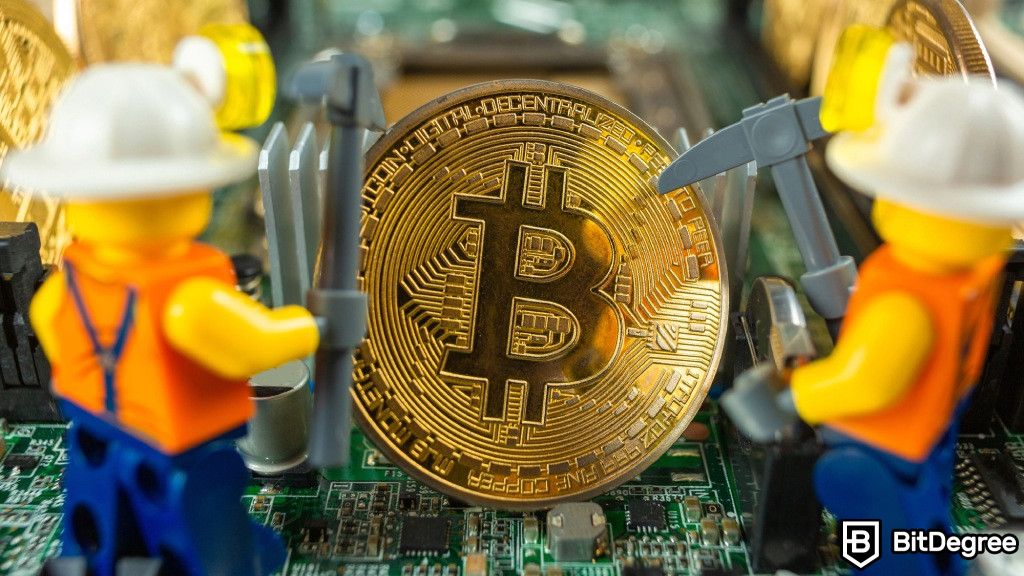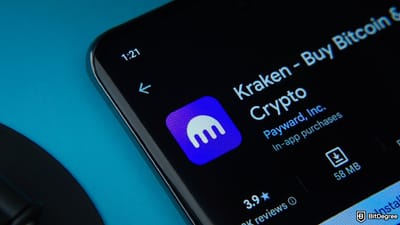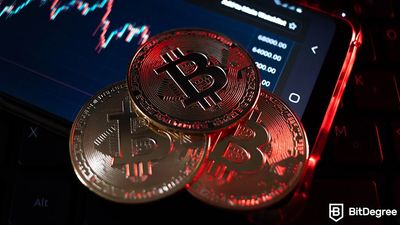Key Takeaways
- The Binance mining pool provides users with traditional pool mining, as well as cloud mining services;
- Binance Pool fees differ based on the asset in question, but they usually range from 0% to 4%;
- As of writing, the Binance mining pool supports BTC, BCH, LTC + DOGE, ETC, ZEC, ETHW, RVN, DASH, and CKB mining.
Ace quick missions & earn crypto rewards while gaining real-world Web3 skills. Participate Now! 🔥
Are you interested in crypto mining but have reservations and are not sure where to start? Well, you’re in luck because, in this tutorial, I’ll take a look at the Binance mining pool, Binance cloud mining, and topics beyond that.
After all, despite the inherent hurdles, crypto mining holds tempting rewards. Not only do you keep the blockchain secure, paving the way for crypto’s further usage, but crypto miners tend to generate tens of millions in revenue each day. So, it’s understandable why mining is gaining so much traction despite the difficulties.
Besides, services like those provided by Binance allow users to mitigate some of the mining exertion. So, let's talk about what pool Binance can offer and how you can adapt it to your mining needs (I'll even touch upon the Binance mining pool profitability).

Did you know?
Subscribe - We publish new crypto explainer videos every week!
What is the Metaverse? (Meaning + Animated Examples)
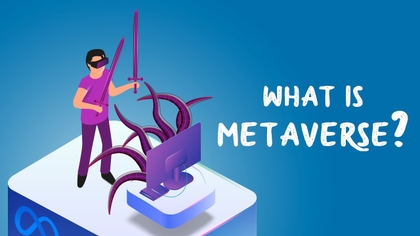

Table of Contents
What is the Binance Mining Pool?
The Binance mining pool (or Binance Pool) is a platform that allows users to participate in cryptocurrency mining. Mining pools are collaborative networks where multiple miners combine their computational resources to increase their chances of successfully mining blocks and earning rewards.
Latest Changelly Coupon Found:The idea behind the mining pool is to make mining a bit less competitive by allowing even those with less computing power on their hands to still work towards crypto rewards.
As one of the world’s largest crypto exchanges, Binance recognizes the importance of mining and, therefore, is committed to using the resources (like its capital or technology) at its disposal to facilitate mining pools and offer mining and trading services within one platform.
The Binance mining pool is reportedly dedicated to improving miners' profit, offering safe and comprehensive services. The pool connects a group of miners so they can collectively work towards obtaining their chosen crypto.
For its pool, Binance allows users to pick from a list of available coins, including BTC, BCH, ZEC, and more. Miners can easily switch between coins, so there’s an additional layer of adaptability. However, if you’re hoping to start Binance coin mining, I have to disappoint you - there’s no option to mine BNB on Binance. This is the case BNB is based on the Proof of Staked Authority (PoSA), so it's not minable.

Now, do note that users can have more than one mining account depending on their needs, which can be utilized for multiple purposes, such as managing multiple proxy servers or mining farms.
To proceed with the mining endeavor, you have to set up a sub-account for Binance mining and connect your mining device to the platform. This mining account is tied to the main Binance account, and cannot be deleted once created.
Binance offers several mining pool nodes available in certain regions, including Europe, America, Southern China, and Northern China. The list could expand in the future to accommodate the growing user base.
Though, note that the users don’t have to manually seek out the nodes since the Binance mining pool automatically determines which one is nearest (and, in a way, more beneficial). Such a system keeps mining operations stable and prevents delays.
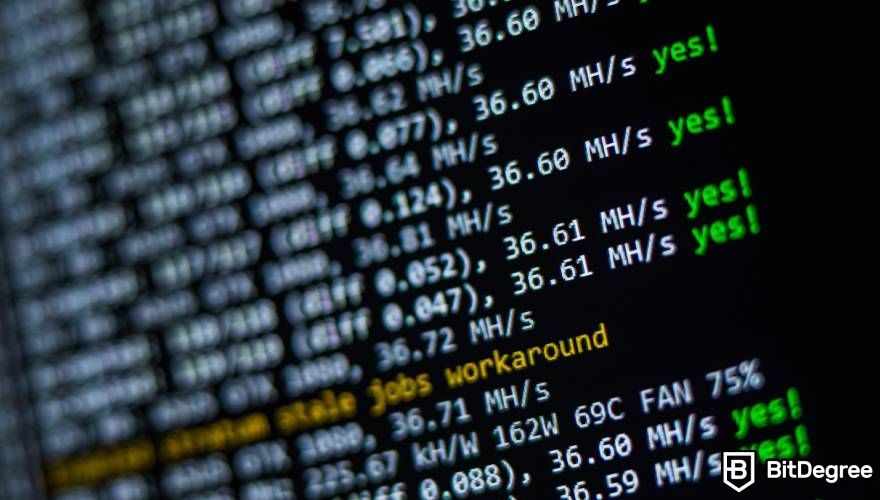
On that note, it’s worth recognizing that at least some delays are inevitable. Due to the nature of mining, the machine periodically submits the results of its calculations back to the Binance mining pool. However, because of the hiccups in the network or other factors, the submission might not reach its destination and is therefore considered invalid.
The number of invalid submissions compared to the total number of submitted results is called the rejection rate. The rejection rate should be below 2%, and the lower the percentage is, the more efficient the miner.
However, as stated in many user Binance Pool reviews, you shouldn’t panic if you see a spike in rejection rates. That might usually be the case because of some issues with the stability of the pool network, not individual miners.
Binance Mining Pool Features
Now, let's get a bit deeper into this Binance Pool review and look into its features that cover anything from earnings to integration with the Binance ecosystem, and even extra services.
When it comes to the Binance mining pool profitability, it's worth noting that Binance supports several earnings distribution models, including FPPS (Full-Pay-Per-Share), PPS+ (Pay-Per-Share +), PPS (Pay-Per-Share), and PPLNS (Pay-Per-Last-N-Shares). These models also partially impact Binance Pool fees since they have different monetary distributions.
FPPS and PPS+ both pay per share, and the users also get a portion of transaction fees. With both of these models, the miners will get paid regardless if the pool solves the block or not. Participants are paid based on shares (hash attempts they submit).
Even if the price per share is usually on the lower end or nominal, it’s a constant stream of revenue that adds up over time. According to Binance, the models ensure the earnings of miners can be boosted by up to 5%, likely because of the fee distribution.
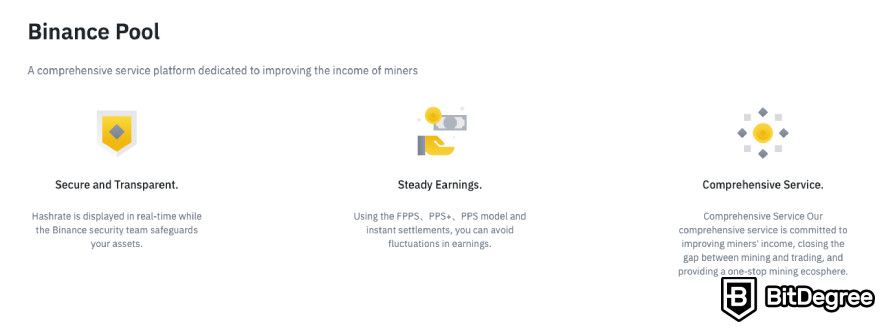
The PPS model pays for the shares submitted, providing a steady stream of earnings as well, but in this case, the mining pool fees are deducted from the income.
Lastly, PPLNS’s model calculates earnings according to the number of shares you’ve submitted. However, the payment is only distributed after the pool succeeds in mining a block.
This model relies more on luck since the participants of this type of pool system can reach great earning potential if they successfully find several blocks in a day.
To those looking for more flexibility, the company introduced the Binance Pool Savings service that caters to high-earning miners.
The Binance mining pool supports several currencies and utilizes multiple algorithms. The pool ensures the users have low fees and high yield. The aforementioned local nodes help boost the miners’ performance.
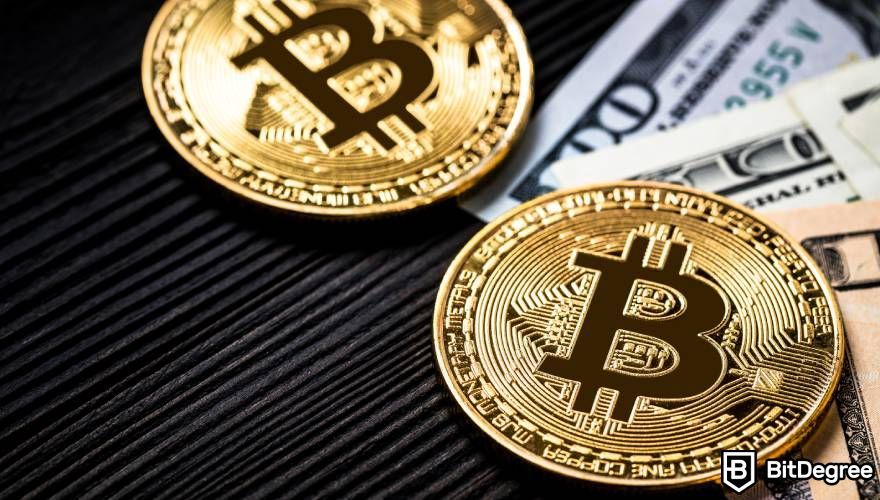
It's worth noting that Binance uses Cloudflare to safeguard the participants from DDoS attacks. Besides, users can access full-time customer support, and VIP customers even get customized services, such as the BTC Transaction Accelerator.
BTC Transaction Accelerator is a service that speeds up the confirmation process of transactions. It’s particularly useful when the network is under a heavy strain since the miners working with Bitcoin would know to prioritize these particular transactions, which hastens the confirmation process.
The Binance mining pool is closely associated with the rest of Binance’s services. Due to the pool’s inherent integration with Binance’s original platform (through the link between main and sub-accounts), the miner can utilize their Binance wallet in conjunction with the pool’s features.
If you’re planning to mine in substantial quantities, it’s worth noting that VIPs have special quotes for trading in large volumes and additional discounts for spot and futures trading. By the way, to become a VIP, you have to increase your trading volume and BNB balance.
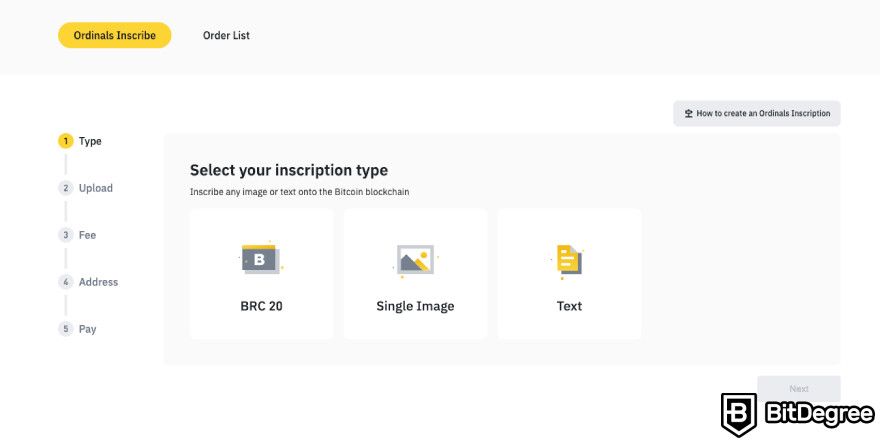
Now, the last noteworthy feature of the Binance mining pool is the possibility of creating Bitcoin Ordinals. What are those? In essence, Bitcoin Ordinals provide a way to create Bitcoin NFTs by linking certain data to individual satoshis (1 satoshi = 0.00000001 BTC).
Such a process of attaching information is known as inscribing. The Binance mining pool supports the service that enables users to create Bitcoin Ordinals with three inscription types: BRC-20, image or text.
The inscribed satoshis are included in the Bitcoin blockchain together with all the information that’s attached to them, which ensures its security and immutability. However, because it needs to maintain its own space within the blockchain, inscribed satoshis are, in turn, increasing network fees.
Binance Pool Fees and Earnings
Now that I have covered what Binance mining pool is, it’s time to turn to the financial side of things. As mentioned above, the pool employs several different modules to distribute earnings. This profit is based on theoretical income and trading fees, and is divided between the participants according to their hashrate.
The settlement cycle takes approximately 24 hours (00:00 each day to 00:00 UTC the next day.) Payout is marked to take place from 02:00 to 10:00 UTC daily.
Miners can use a speculative calculation tool attached to each of the mineable assets to see how much earnings they should expect according to the hashrate they can provide.
Besides that, the Binance mining pool has one more earnings-adjacent perk - merge mining. It’s a service that allows miners to earn additional crypto (not necessarily of the same type they’re mining).
For example, if the participant is intent on mining Litecoin, the merge function could gift him with bonus DOGE tokens. Though, miners should take a closer look at the settlement module of the additional coins since it might differ from the main asset you’re mining.

The bonus coins for mining are not set in stone either, so it’s a good idea to keep an eye on any changes on Binance’s side.
There’s also a supplementary element of unit profit details. Each crypto you can mine has this component, allowing you to make an informed decision based on past data. The information includes unit profit and coin price and is divided into hourly or daily increments.
But just as important as the earnings are the Binance Pool fees, and here’s where things lose the universal path that earnings followed. Fees can be vastly different based on which crypto you want to mine. For example, the Bitcoin mining fee is 4%, while Litecoin maintains a 3% fee.
The service charge can go as low as 0%, depending on the asset you pick for mining. You can see each fee next to the asset you choose to mine.
What is Binance Cloud Mining?
When talking about the Binance mining pool, it's inevitable to discuss Binance cloud mining, which is a service that allows people with no experience or dedicated equipment to participate in mining efforts. Simply put, you purchase cloud mining products that allow you to earn mining rewards.
The products differ according to the crypto you want to mine, as well as other factors, such as time, cost or output. Keep in mind that it's not there on a permanent basis, meaning the products are sold on rotation and can be gone or sold out after a while, so it’s a “first come, first served” principle.
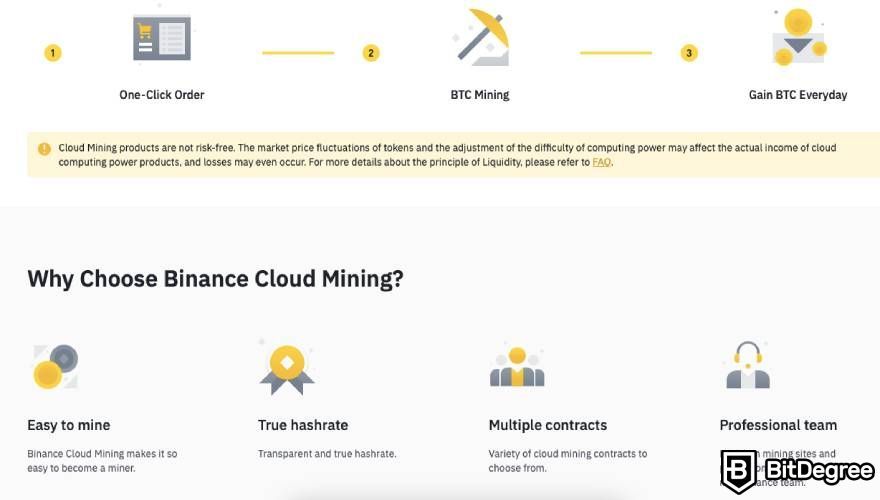
As an example, let's say you find an option that offers BTC mining for 360 days. You can then check how much 1 TH/s would cost (the combined price of hashrate and electricity fees) and take a look at the estimated output numbers, a tentative calculation of how much crypto you’ll get over the mining period.
If you’re satisfied with the product, there’s one more important step you have to complete, and that’s selecting the hashrate you want. Each cloud mining product will have its own restrictions, such as minimum purchasable TH/s or personal purchase limits.
Unlike with the Binance mining pool, you can purchase cloud mining products with USDT. The money will be deducted from your spot wallet. Once purchased, the order can’t be altered or canceled, so you have to decide if you can afford to subscribe to the product before payment.
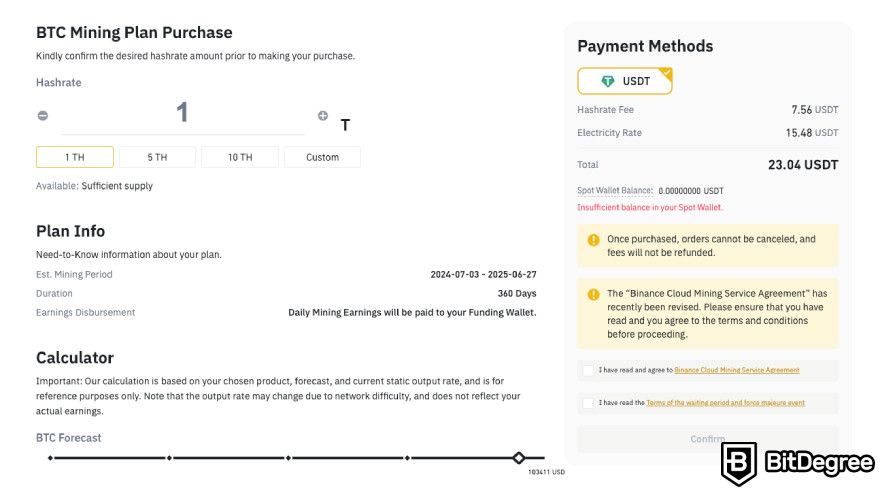
However, the subscription can be made void by Binance itself for a variety of reasons, and in that case, users will receive a refund based on the number of days remaining to the service at the time of the cancelation.
According to the ToS, Binance promises to provide the participants of Binance cloud mining with at least 95% of the total hashrate. If the percentage drops below this, the company promises to either compensate the difference or issue a refund.
After the purchase, you can track the progress and performance of the mining product in the order history.
All technicalities aside, cloud mining services act like a middleman between potential participants and the mining pool. Instead of investing in and maintaining their own equipment, miners can utilize Binance’s tools for the purpose.
This broadens the accessibility of mining because there’s no need for additional preparation. All you need is enough crypto capital to cover the fees, and you can become a part of the miner community.
Why Participate in Mining Pools?
As previously discussed, the Binance mining pool represents the collaborative efforts of multiple miners to collectively tackle complex computational tasks within the blockchain, thereby enhancing efficiency and pooling together the resulting rewards for distribution among participants. Though, initially, mining was a solo activity.
At its inception, mining required only a simple computer to solve the mathematical problems that powered the Bitcoin blockchain. However, as time went on, more people jumped on the crypto train, and it gradually picked up speed.
Nowadays, you need to have specialized mining-oriented equipment just to begin competing against others, but even that doesn’t guarantee success. While the equipment requires a large investment, there’s little chance you would be able to successfully mine a block.
But the issue is not only the equipment itself; it’s the fact that it needs to complete as many hash computations as possible to succeed. This goal can naturally be achieved quicker and more efficiently if people pool their resources together.
That's where mining pools come in since they connect users in their common goal. The rewards are then divided among the participants depending on their contribution and the earning model that’s used by the pool.
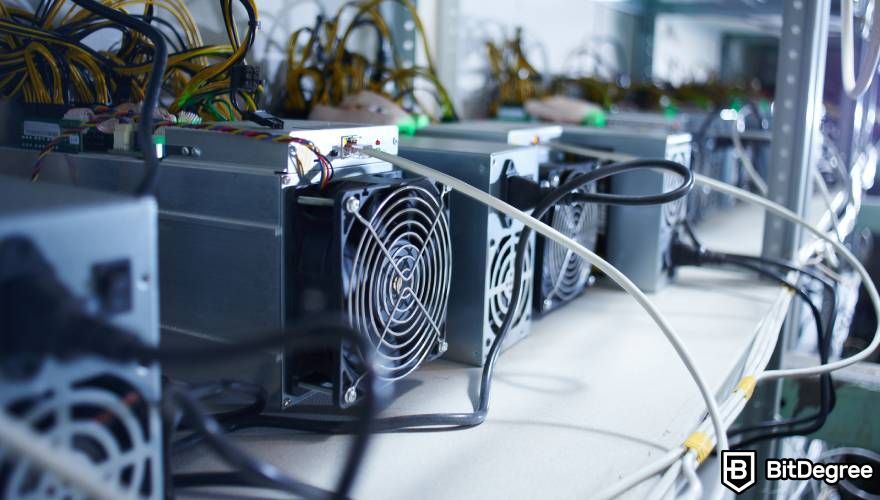
While the distribution of rewards might seem like a poor substitute for the whole prize, it’s worth noting that the computing power required for mining is often too high for one person to afford. Mining demands not only equipment but electricity, too.
The more machines you have, the pricier it gets. By the way, there’s also the luck factor, meaning there’s no guarantee that you will succeed if someone else gets lucky. However, just as rewards are split between participants, so are the expenses (metaphorically, of course). Once you join a mining pool, your one singular mining device will join others, and together, you have a veritable chance to mine a block.
Such collaboration also helps dissuade some of the criticism that’s aimed at mining, mainly the issue of energy consumption. Machines that run mining computations require a lot of electricity, and even back in 2017, the maximum energy consumption of Bitcoin mining peaked as high as 14GW[1].
It's estimated that crypto’s energy consumption could make up approximately 0.5% of total global usage. However, the technology doesn’t stop evolving, and an increasing number of energy-conscious mining equipment is appearing in the market. Renewable energy is also making its way into the crypto industry.
Binance Staking
Now, speaking of a more environmentally friendly alternative to mining, we have staking. Luckily, the platform also provides staking services in addition to the Binance mining pool.
While mining is usually driven by the Proof-of-Work (PoW) consensus mechanism, staking is based on Proof-of-Stake (PoS). After the Merge, Ethereum became one of the biggest coins to use PoS.
Staking serves the dual purpose of facilitating base-layer consensus formation and encouraging economic activities and network growth, leading to stakers earning rewards as a result[2].
Whereas mining requires the use of specialized machinery, staking relies purely on crypto assets themselves. The person who wants to become a validator will place a portion of their coins or tokens to be held in a locked wallet, no longer accessible to them.
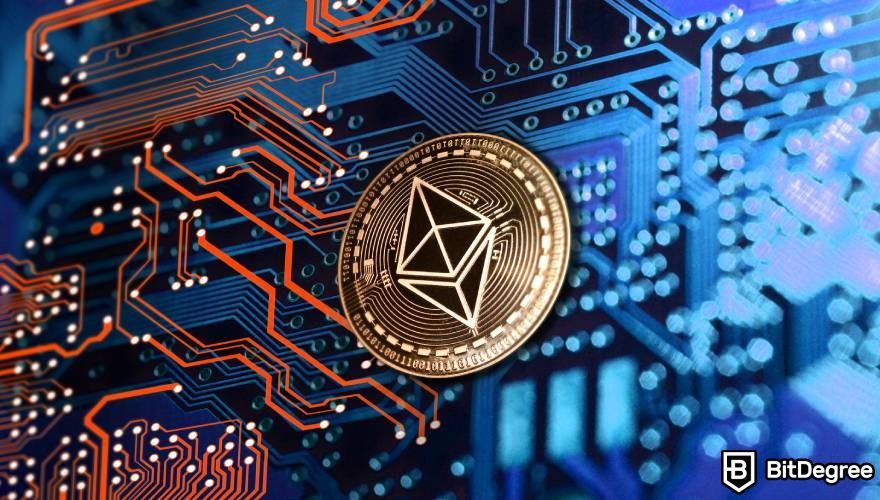
The coins are basically held as collateral to ensure the validator acts honestly and doesn’t make mistakes. If that happens, they will be penalized using the coins they staked.
However, much like with the mining previously discussed in this Binance Pool review, staking can be a costly endeavor. Why? Because, usually, to become a validator on a PoS network, you need to stake quite a number of coins, which in turn translates into a sizeable sum. This might create a barrier for newcomers to the industry or just those who cannot afford it.
For instance, staking directly on the Ethereum network requires at least 32 ETH and knowledge of how to set up and maintain a node.
Luckily, there’s a way around it. Staking ETH on Binance, for example, allows you to start with as little as 0.0001 ETH and all you have to do is click a couple of buttons (there is no need for knowledge of setting and maintaining nodes). The best part is that Ethereum actually offers liquid staking services because it provides ETH stakers with Wrapped Beacon ETH (WBETH).

WBETH is a liquid asset that represents your staked ETH. It can be used however you wish while still maintaining your stake. You can easily exchange WBETH back to ETH, getting your initial stake and any generated rewards. The APR for staking on Binance is dynamic, so it changes periodically based on the on-chain Ethereum staking rewards.
All in all, Binance staking is a great alternative to mining, especially if you have some ETH lying around in your wallet. However, don't forget that any type of earning endeavor in the crypto space carries risks, so make sure to stay cautious and well-informed.
Staking VS Mining
After covering the basics of both mining and staking, let's complete this Binance mining pool tutorial by highlighting the main differences between the two.
The first and probably most important difference is the hardware requirement. Mining, by its very nature, requires a lot of computing power and the machines used in these calculations are specialized for the purpose. With this specialization comes the aforementioned need for energy. Mining is often criticized for the energy it consumes, and it’s one of the industry's main drawbacks.
However, while the energy requirement won’t just evaporate into thin air, there’s a way to mitigate it. Staking is a way of obtaining crypto assets without the strain of mining since it doesn’t need such energy-intensive machines.
Both methods, however, offer pooling systems that are accessible to people regardless of the funds they can dedicate to the endeavor. The shares obtained while mining determine the portion of the reward they will be getting.
The second major difference is tied to the nature of mining and staking, and that’s the model of validation they use. Some blockchains utilize PoW, which inevitably leads to mining as the main way to validate the information and transactions. Staking, instead, focuses on PoS that uses validators and nodes.

Keep in mind, that the users can’t pick the coin they want and then adapt its acquisition to their preferred model, as the models are automatically assigned to assets.
The third distinction would be the nature of the validation mechanism. In mining, participants compete against one another to quickly solve cryptographic equations, and only the winner gets to add the block to the chain.
Alternatively, in staking, one validator is chosen. His staked coins are then held as collateral until he successfully (and correctly) validates the information node and adds it to the blockchain. Simply put, no additional participants are wasting their time or resources on operations that might not yield any reward.
The last point I'd like to make when it comes to staking and mining is availability. In general, there are fewer minable assets than the ones you can stake. This particularly impacts users who are looking for specific coins. Taking the Binance exchange as an example, while you can’t engage in Binance coin mining, you can engage in BNB staking via the BNB Vault.
Conclusions
To sum up all I've discussed about the Binance mining pool and related services, the main takeaway would be that mining pools stand in the golden middle between risk and reward. While you will have to invest to have a proper mining system up and running, it won’t be an uphill battle where you compete against other miners. The reward is shared, but so are the risks.
Binance has a list of coins approved for mining, which includes Bitcoin and Litecoin (no Binance coin mining, though, as it can only be staked).
When it comes to earnings and fees, Binance supports all the main earning models, but they are assigned to coins and cannot be altered. The Binance Pool fees are also based on the asset in question, and usually range from 0% to 4%.
Plus, the platform provides users with the Binance cloud mining service, which takes the hardware entirely out of the equation, so participants can join mining pools with only their assets. Hence, miners' experience when it comes to the Binance mining pool profitability is entirely reliant on which asset they want to mine and which mining type they choose.
The content published on this website is not aimed to give any kind of financial, investment, trading, or any other form of advice. BitDegree.org does not endorse or suggest you to buy, sell or hold any kind of cryptocurrency. Before making financial investment decisions, do consult your financial advisor.
Scientific References
1. S. Kufeoglu, M. A. Ozkuran: 'Energy Consumption of Bitcoin Mining';
2. L. W. Cong, Z. He, K. Tang: 'The Tokenomics of Staking'.

